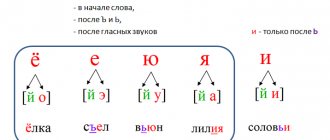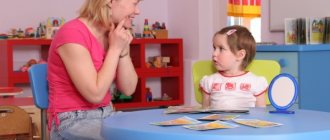Stuttering, logoneurosis, hesitation in speech, dysrhythmia
Stuttering in children is a disorder of the tempo-rhythmic aspect of speech caused by repeated convulsions in the articulatory, vocal or respiratory parts of the speech apparatus. Stuttering in children is characterized by “getting stuck” on individual sounds, their repeated, involuntary repetition, accompanying movements, speech tricks, logophobia, and vegetative reactions.
Neurological therapy classes for the correction of stuttering in our center can be based on various author’s methods: Cheveleva, Vlasova and Rau, Shklovsky, Volkova, Mironova, etc. The main methods of speech therapy work for stuttering are breathing-vocal gymnastics, relaxation of tense articulatory muscles, speech exercises on rhythmization of speech, normalization of its tempo, development of expressive speech intonation, logorhythmic exercises.
Children with stuttering, logoneurosis, and even hesitations in speech must be examined by a neuropsychologist and speech therapist.
Competent correction of stuttering, which leads to sustainable results, must necessarily include a neurocorrectional set of measures (neuropsychological correction, neuroacoustic programs) and a system of “correct” speech therapy classes.
Stuttering in children is unintentional stops and hesitations in oral speech that arise as a result of a convulsive state of the speech muscles.
It must be remembered that in addition to speech spasms, stuttering in children is accompanied by a disorder of higher nervous activity, which in some cases may be associated with a neurotic reaction, in others with organic damage to the central nervous system. Therefore, it would be wrong to consider stuttering in a child as a purely speech problem; The study and correction of stuttering in children is impossible without the integration of knowledge from the field of neuropsychology and the development of brain areas.
This is where the root of problems with speech hesitations lies.
Depending on the pathogenetic mechanisms underlying stuttering, there are 2 forms of stuttering in children: neurotic (logoneurosis) and neurosis-like. Neurotic stuttering in children is a functional disorder; neurosis-like is associated with organic damage to the nervous system and brain.
In the most extreme cases, stuttering can make speech and communication nearly impossible. The severity of stuttering may vary for the same child in different situations.
Depending on the nature of the course, the following variants of stuttering in children are distinguished:
- wavy (stuttering increases and decreases in different situations, but does not disappear);
- constant (stuttering has a relatively stable course)
- recurrent (stuttering occurs again after a period of speech well-being).
Children who stutter often exhibit enuresis, night terrors, increased anxiety and vulnerability. Therefore, ignoring stutters and “running” this problem is DANGEROUS.
Perinatal brain damage in children can be associated with toxicosis of pregnancy, hemolytic disease of the fetus, intrauterine hypoxia and asphyxia during childbirth, birth injuries - and all this can subsequently lead to stuttering and hesitation in speech.
Children who are physically weak, with an underdeveloped sense of rhythm, general motor skills, facial expressions and articulation are more susceptible to the development of stuttering.
The increase in the incidence of stuttering is directly related to the introduction of computer games and various computer technologies into everyday life, which unleash a huge flow of audiovisual information on the fragile nervous system of children.
It should be remembered that the processes of maturation of the cerebral cortex and the formation of functional asymmetry in brain activity are generally completed by the age of 5, therefore exposure to any stimulus that is excessive in strength or duration can lead to a nervous breakdown and stuttering in children.
The immediate causes of stuttering in children also include immediate mental shocks or long-term mental trauma.
Stuttering in children can be caused by imitation of people who stutter, overload with complex speech material, and retraining to be left-handed. Experts point to the connection between stuttering in children and left-handedness and other speech disorders (dyslalia, tachylalia, dysarthria, rhinolalia). Secondary stuttering in children can occur against the background of motor alalia.
In the case of neurosis-like stuttering, which occurs against the background of organic damage to the central nervous system in the perinatal or early period of child development, the disorder develops gradually. Neurosis-like stuttering in children appears from the moment speech begins or at the age of 3-4 years, i.e. during the period of formation of phrasal speech.
Children with neurosis-like stuttering have impaired general motor skills : their movements are awkward, constrained, and stereotyped. Characterized by sluggish facial expressions and poor handwriting; Dysgraphia, dyslexia and dyscalculia often occur. The course of neurosis-like stuttering in children is relatively constant; Speech deterioration can be caused by fatigue, increased speech load, and somatic weakness.
Physiological iterations (from the Latin iterare - repeat). M. Zeeman notes that repetitions are generally often observed in children's speech, and this is not a painful sign, but a physiological one, characteristic of a certain period of development of children's speech. Some authors (Dorotti, Davis, Johnson, Despert) believe that iteration is characteristic of 80% of children during the period of active formation of phrasal speech in them (2 years - 5 years). If there are no complications, this repetition goes away as soon as the child, with the strengthening of speech conditioned reflexes, acquires sufficient confidence in expressing his thoughts in speech.
Physiological hesitations and repetitions in a child’s speech are a consequence of the fact that the development of thinking outstrips the development of his speech capabilities. It is known that the speech capabilities of a young child are limited by the period of formation of speech itself and its apparatus: the active vocabulary is small, the forms of expression of thoughts are imperfect, articulatory movements are not clear enough, etc. But the child already understands a lot, and wants to know even more. All his activities and communication with others are usually accompanied by a high emotional upsurge. This leads to the fact that the speech of a child from 2 to 5 years old is usually replete with various kinds of repetitions, rearrangements, stumbles, unclear sound pronunciation and phrasing of thoughts, scatteredness, chaos and other imperfections.
Such a state of speech in children at a certain stage of their development is natural. Over time, under the influence of the educational influence of others and the development of speech movements, children's speech becomes leveled out, and its imperfections disappear without a trace.
Physiological imperfections in children's speech (including hesitations) can be delayed in a child due to various unfavorable factors (illness, injuries, incorrect teaching techniques, unfavorable speech environment).
Children with delays in speech development often experience speech hesitations. The inability to immediately find the right word, form a grammatically correct phrase, clearly pronounce this or that sound - all this can be the reason for a violation of the fluency and tempo of a child’s speech, i.e. cause unnecessary pauses, stumbles, and repetitions.
This usually happens when the child is not helped in accumulating and correctly using new concepts and words, when parents do not set themselves the goal of gradually introducing him to the world around him, and do not point out the external and internal features of the objects, events, and phenomena surrounding him. In addition, often parents not only do not correct the shortcomings of their children’s speech, but also imitate them, cultivate them in the family, demonstrate them to relatives and friends, and are touched.
Lingering physiological speech imperfections are often observed in children in those families where the parents themselves speak very unorganized, quickly, swallowing and blurring the endings of words or entire words in a phrase.
A child group that is unfavorable in terms of speech can also have a negative impact on a child’s speech formation. In this case, the greater tendency of young children to imitate matters.
“At our dacha, a neighbor stuttered badly,” nurse Z once said. “I was 5-6 years old at the time, but I remember well that I really liked to “stutter.” It seemed to me that the neighbor was saying that on purpose. It seems that I “stuttered” quite successfully, until one day my mother noticed my quirks. It is to her that I apparently owe most of all for my normal speech today. I remember she explained to me first of all that the neighbor didn’t say that on purpose. And subsequently many times she drew my attention to the beautiful, expressive speech of artists in children's radio programs. We even improvised ourselves, telling fairy tales in person. I liked the game of beautiful speech.”
Some authors (M. Zeeman and others) see iteration as an independent speech deviation, others (A. Gutsman, E. Freshels, M.I. Paikin) consider iteration to be the initial stage of stuttering. According to the latter, after the iterative stage of stuttering, the child becomes fixated on his defect, and later, side affective states appear, which can be considered legitimate, since stuttering of a non-convulsive nature can develop into stuttering of a convulsive nature. But this is not in all cases. An example is the different prevalence of physiological hesitation (80%) and stuttering (2%) among children.
Consultation for parents “Stuttering or stuttering?” consultation on the topic
It happens like this: one fine day, out of the blue, your child starts saying something strange: “No, no, I don’t want porridge!” It becomes alarming in our hearts, because each of us has encountered people who stutter, we can imagine the restrictions that this illness imposes on normal speech communication. Still, there is no need to panic. Stuttering is very often confused with so-called “stammers” (physiological iterations). Both speech defects are very similar in their manifestations: they are related by the disturbed rhythm of speech. It is necessary to be able to distinguish stuttering from hesitation, because the content of correctional work will depend on this.
Stuttering is a violation of the tempo and rhythm of speech due to a convulsive state of the muscles of the speech apparatus. Convulsions come in different localizations: vocal, articulatory, respiratory.
Physiological hesitations (iterations) are a common phenomenon in the speech of children 2-5 years old, which requires a different correction than stuttering and usually occurs when the development of a child’s thinking outstrips his speech capabilities. Often accompanied by good development, both mental and physical. There is a high risk of stuttering in children who are emotional, very developed, and impressionable. Usually mothers begin to panic, expecting the worst - stuttering. Remember that hesitation is distantly related to stuttering. However, if you do not pay attention to repetitions of syllables and words in speech in time and do not take preventive measures, then the risk of stuttering is quite high.
As soon as you hear “stumbling” in your baby’s speech, try to determine whether it is stuttering or hesitation.
- When hesitating, as a rule, there are no spasms in the mouth, neck, etc. as opposed to stuttering.
- Pay attention to how the child reacts to requests to speak better, slower, more smoothly. If a child has a stutter, then his speech after this request will only get worse, but for a child with stuttering, it will be better. People who stutter are characterized by a painful fixation on their defect, and this leads to additional deterioration of speech.
- Analyze the reasons for the “unexpected” disturbance in the rhythm of speech in a child. The roots of a child’s problem with hesitation go to the area of emotions, characteristics of the nervous system, problems of child-parent relationships; hesitations are often a symptom of neurosis. It happens that they appear when the child is especially tense (says something long, new, difficult), excited, etc. At such moments, some of the children begin to twirl their hair on their fingers, bite their nails, even blush, and the children hesitantly begin to repeat the first syllables or words. Stuttering is a neurological problem and is more difficult to correct than stuttering. It is believed that stuttering is always of hereditary origin (a great-grandfather could stutter, and a predisposition to stuttering was passed on to his great-grandson).
If the peculiarity of speech does not disappear within two to three weeks and even tends to worsen, it is time to take action. Visit a neuropsychiatrist. He will help you with diagnosis, that is, they will identify stuttering (sometimes called logoneurosis). A neuropsychiatrist will prescribe medications that make sense to take if the child actually has a moderate or severe stutter.
For stuttering, medications are not needed, except in situations where they were caused by severe stress. When correcting stutters, do the following:
- We consult and work with a child psychologist. A psychologist will help eliminate the cause of stuttering. Various methods of child psychotherapy help well: fairy tale therapy, sand therapy, art therapy.
- We are working with a speech therapist. The speech therapist teaches the child breathing exercises, relaxation, and control over the fluency of speech in a playful way.
- We provide a relaxing massage course.
- We spend a lot of time in the water. It is best if you take your child to the pool, but in case of somatic weakness, regular games with water at home are quite suitable. There is a rule: the more excitable the baby, the more water he needs.
Advice for parents every day.
You should reconsider your behavior in relation to raising your child: inflated demands, alienation, criticism, ridicule, irritation - all this can provoke hesitation.
- Watch how quickly or slowly you speak to your child and how loudly: if hesitation appears, then you need to speak more quietly and more slowly.
- Convince yourself: hesitation is not a death sentence, but a symptom of a deeper problem, usually of a psychological and pedagogical nature. If you worry too much, the baby, looking at you, will literally intuitively feel: “Something is wrong with me”; Nervous tension is growing.
- Make particularly serious demands on your daily routine. It is necessary to limit watching TV and computer games to 15-20 minutes a day.
- Before bed, turn on quiet instrumental music, adaptations of classics for children. Such musical compositions have a good psychotherapeutic effect.
- If your baby begins to stutter due to intellectual overload, for example, in an early development school, then you need to “slow down” the educational process. Let the baby do nothing for a month or two, play around, do nothing.
- Under no circumstances should a child’s attention be focused on the uniqueness of his speech. That is why it is better not to demand that he repeat the word correctly and generally give any assessment to the statements. If the child begins to stammer a lot during a conversation, simply tell him: “Let's try to sing this word” or: “Let's say this word in a whisper.” Show him how it's done. Usually there are no stutters when using these techniques.
- When communicating with a child who hesitates, let him feel that no one is rushing him to tell him that everyone will always wait for the end of his thought. This means that you don’t need to push him when answering, or suggest a word, and don’t use impatient gestures. Wait silently until he selects the words and the correct grammatical form for the statement. If hesitations in the child’s speech appear infrequently, do not in any way affect the quality of communication, and do not strain the child himself, then there is no need to do anything other than a consultation with a speech therapist.










